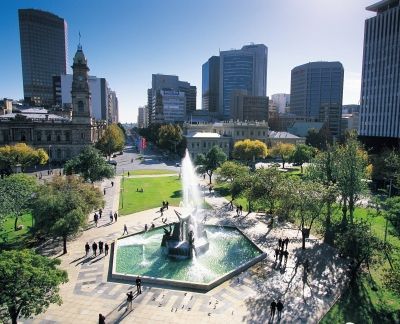I live in a city that is roundly lauded for how green it is. Such greenness is most frequently assessed from the air. As people fly into town, they are greeted by an ever-expanding urban vista; one that is cloaked in canopy. Flying over the city proper, the surrounding parklands on the edge of Adelaide’s square mile are evident and welcoming. Nay, they are even surprising. This happens even in summer, when the blazing sun turns the luscious greens into the faded yellows, browns, and olive greens of gums preserving water.

Yet, driving out of work, not far from Victoria Square, the other day, I was given reason to pause and wonder. Victoria Square is undergoing redevelopment; it’s the kind of redevelopment that governments do from time to time to prove both their might and their ‘commitment to the people’. Whatever that is.
Overlooking the tall cyclone fences keeping us all out of this central, necessary, and breathable urban space – and overlooking it casually – I was gripped by a sense of horror.
Where were the trees?
Had they been pulled out?
Or had I, in my complacency, always assumed, and thereby imagined, their existence? (Clearly not, they’re in the photo above.)
I’m bothered by the notion that I never paid enough real attention to recall such a significant detail.
Even more horrifying to me is the sudden realisation that living, established, healthy beings can be destroyed and removed because they don’t fit someone’s “vision”.
Don’t get me wrong. I’m in my ’30s. It’s not like I haven’t had this sort of thought before. Let’s say it was the first time I had been actually viscerally gripped by the horror of it all. It always meant something; now it was really affecting me.
There are a great many arguments and rationales for said removal of trees and living things in the name of both economy and landscaping. I prefer to call it lanarchitecture: the terraforming of our immediate environment as though we build it the way we want to see it, without any real regard for the life it sustains.
Generally speaking, ‘landscape’ as a whole has gotten ever more neat and tidy on its own, as architecture has grown sterile and lifeless. And as art herself has become a luxury. It’s a well-regulated, underfuded, gradually fading luxury; especially as people lose the art of writing properly, reading, paying attention, using imagination, and spelling.
God, the spelling. But that’s another story altogether.
Can we start to sadly consider that the human eye for beauty is becoming dulled? And if the human sense of beauty is becoming dulled, is that, too, a measure of humanity’s weakened grasp of its emotions?
In discussing gardening, Dominique Brown at Cracked.com wrote:
“A different part of the brain is activated by aesthetics; it is the most human part. It bears keeping in mind. Beauty matters. You can be a garden geek and still not be a gardener.”
And some studies would indicate that our ability to express and perceive, and appreciate, emotion is dulling. Take, for instance, Acerbi, Lampas, Garnett & Bentley’s study, The Expression Of Emotions in 20th Century Books. That study scanned books using a Google service (so, approximately 4% of all books published between 1900 and 2000) for ‘mood’ words. The study’s results demonstrated a decerease in the overall use of mood words in the timeframe under scrutiny.
Interestingly, fear had risen a comparable amount.
Even more interestingly, if you search for fear and control on the internet, you’ll most likely get results featuring anxiety disorders.
Going to the next level, I find it fascinating that something like 3 in 4 people I know are on some kind of medication to reduce their anxiety. Why are they scared?
What is a natural reaction to fear? Controlling the environment. Maybe looking at it in a backwards comparison based on absolutely nothing but my own experiences and the situations that I have been in, we could consider that the emotionlessness of architecture and landscape comes from an inner recess in which people desire a more simplistic life. One that doesn’t interrupt their plane of sameness.
But I digress.
There is a plethora of information out there about how much trees cost to maintain; and even whether it is viable to consider trees in a carbon-reduction plan (high cost versus low short-term-gains in carbon reduction). And in a little-known fact, Adelaide City Council has recently changed its Significant Tree Laws. While the changes look acceptable, they are actually a little bit insidious. Professor Leadbeter at the Adelaide Law School writes:
“… unless trees are Willow Myrtles or of a Eucalypt species, even if they meet the measurement criteria, they will not be regulated trees if they are located within 10 metres of an existing dwelling…”
Um, what? 10 metres? Well, we may as well destroy all of them, then.
Even more disturbing, he continues:
“Secondly, there is a list of exotic tree species, many which have been traditionally grown in the Adelaide area since European settlement in 1836 which can also be removed or pruned without approval, as can trees effectively listed as pest plants under the provisions of the Natural Resources Management Act 2004,[10] even though they may meet the measurement requirements for regulated trees.”
Are the people who make these laws and rules aware of the huge benefit of trees? Do they know that shoppers may spend up to 12% more in forested urban retail areas? Such a benefit is even aside from the benefits of spending the time, water, and ‘resources’ (i.e. people) in tending to them.
Trees are biophilic. Maybe that’s why their removal affects me so much. Trees also affect incoming wildlife in a positive way; as do they (generally) positively impact soil composition, they recycle the air, they continuously help to renew life.
They also make people happier. Do the people who make rulings about tree removal consider that gardens and trees in general “improve human heath, extend life spans, reduce violence and vandalism, lower blood pressure and save our society a fortune on medical and social infrastructure costs”?
There already is, as GM Moore writes, “… a tendency for politicians and bureaucrats to see any open space whether public or private as ornamental and therefore ripe for development.”
But Moore also points out that Australian cities will only be sustainable if the designated open space is enough to balance out the high resource demands of modern society and culture.
“It is often forgotten that the major cities of Australia are biodiversity hot spots (Roetman and Daniels 2008). The parks, gardens, streets and front and backyards provide a very diverse range of plant species that generate a myriad of habitats and niches for wildlife such as birds and mammals, reptiles, spiders and insects. There is also a diverse range of soil types that contribute to massive soil microflora and fauna. High density urban developments and inner city renewal make it virtually impossible to grow trees in places that were once green and leafy. The real and full costs of such developments are rarely ever calculated.”
It occurred to me, as I drove around Vic Square pondering the issue, that my horror didn’t just stem from my knowledge and passion for biodiversity and sustainability, but from my intense, very personal sense of everything being connected to a whole. We are all connected. I am part of those trees, and vice versa.
No matter how much you consider trees in any particular regard, from carbon sinks to economic drains; from stands of beauty to the complex biophilic beings that they are; you can never escape the philosophical truth that all trees are simultaneously alive and dead, that they die as they grow, and that in their deaths – as in their lives – they support an ecosystem unique to themselves and their environments, even while they bring benefits into said ecosystems. A ghost gum in a city, for example, supports different wildlife to that of a ghost gum in the bush, by dint of context. It might only be a slight difference – e.g. the visiting birdlife – but it is still a difference.
How, then, is anyone justified in removing such a beast for design or vision purposes, unless one is building over the top, and the being is in the way (and will be replaced somehow)?
Oughtn’t a sustainable plan work around pre-existing, established trees? They should, and they can. It is not impossible, even when the existing trees are considered damaging in terms of binding soil, and throwing a huge amount of shade, thus affecting the wellbeing of other plants. The existing trees might make you have to reconsider what you plant around them, and how you design your garden. It is not impossible. It just might not fit the plans you create using CGI. The other difficult thing is getting corporations to understand the importance of these principles.
What we need to understand, though, is that corporations, although run by people, are not human constructs insofar as being designed to work for people. They are alien things that have no appreciation for beauty, happiness, wellness, or human evolution. They worship Money, and everything works to Save or Create more Money.
It means that I really oughtn’t to be shocked about anyone pulling trees out. I understand the hows, whys, and wherefores. I just don’t intrinsically “get” it.
Maybe I am not meant to. Most likely, I am much more human because I don’t.

I agree 100%!
Thanks, Janiece! 🙂
A must read post: On Landscape Visions and Humanity http://t.co/QQYXcplq5z via @biodagar
Thank you so much for sharing my work! xx